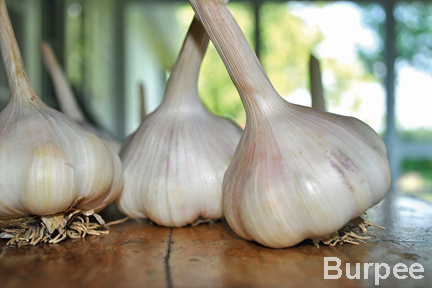
What’s not to love about the stinking rose?
Other than its name, of course.
Garlic has been called the stinking rose for nearly a century, thanks to a French writer and physician, Henri Leclerc, who in 1918 roughly translated garlic’s ancient Greek name, scorodon, to skaion rodon, and then to rose puante, or stinking rose.
Leclerc apparently did not intend the name to become a term of endearment. But stinking rose stuck, and when garlic aficionados use the term today, it’s often accompanied by a sly smile.
But garlic by any name has been an essential ingredient for thousands of years — in food as well as in medicine, rituals and even commerce. It’s said that during the time of King Tut, 15 pounds of garlic could be swapped for a healthy male slave.
Fortunately it’s far easier to obtain the pungent plants today.
Garlic is simple to grow in the garden. And October is the time to plant it.
So Many Choices
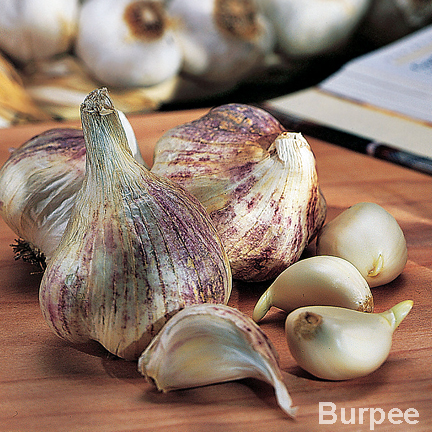
While hundreds of different varieties of garlic are cultivated throughout the world, they are split into two broad groups: soft neck (Allium sativum) and hard neck (Allium sativum var. ophioscorodon).
Soft neck garlic is the one most commonly found in supermarkets, and is grown widely in California, Texas, Louisiana, Mexico, Spain, Italy and France. The bulbs are sheathed in layers of papery parchment that run up their necks, making them easy to braid or hang on a string.
Most soft necks are artichoke types: somewhat like the scales of an artichoke, they bear larger cloves in an outer ring, then smaller cloves within, all encased in white or off-white parchment. They include California Early, Early Italian and Extra Select.
A second type of soft neck is called silverskin, and includes Nookta Rose and Silver Rose. The papery covering on these bulbs is bright white or silver, and the bulb is composed of many smaller cloves.
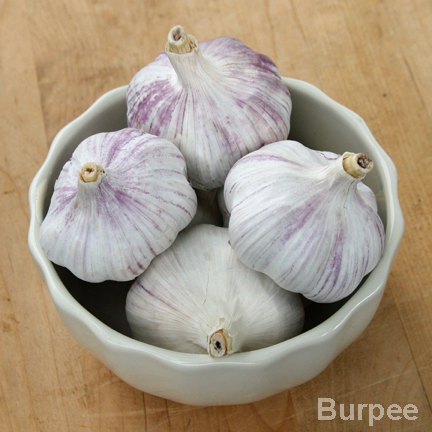
Hard neck garlic has a woody stem and a stiff neck, and is typically grown in Central Asia and Russia. Its cloves are fewer, but more balanced in size, and form a circle around the thick stalk. Above ground in spring, the stem sends up little bulbils, or scapes, which can be harvested. Many of the hard necks are easier to peel and tend to have stronger flavors than the soft necks.
As to which kind to grow on the Central Coast — soft neck garlics have been bred for mild climates with temperate winters and summers. They are your best bets in Santa Maria and Lompoc.
Most hard neck garlics have been bred for northern climes with colder winters, cooler springs and hotter summers. While they are not likely to do well along the coast, select varieties such as Korean Red and Spanish Roja may be worth a try in hotter, inland valleys, such as Santa Ynez.
In the Garden
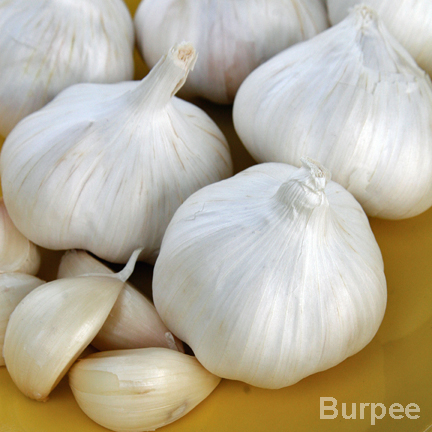
Garlic is slow to reach maturity, often taking a full nine months from planting to harvest. So plant it where you can leave it alone for a long time.
Good drainage is key. Without it, you risk your bulbs rotting in cool, wet soil over winter, and never even knowing it.
For folks with heavy clay, it’s imperative that you plant in a raised bed or container in order to keep the water moving. For those who might otherwise bemoan their sandy soil, that’s now an advantage.
Either way, however, mix a few inches of well-aged compost into the top 6 inches of soil before planting, to improve the fertility and tilth. Also make sure your garlic will receive full sun for at least 4 to 6 hours during winter, and even more next spring and summer when the sun swings higher in the sky.
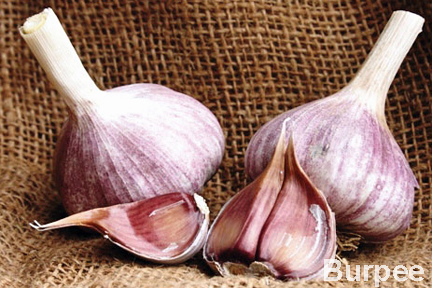
After your soil feels fluffy and light, use your finger or a trowel to shape a furrow a couple of inches deep and several feet long. If you plant in rows, space the furrows 12 to 15 inches apart.
Break open the bulbs, then space the individual cloves 4 inches apart in the furrow. The cloves should be flat-side down and tip-side up, and deep enough that their tips will end up 2 inches below the surface.
Cover up the bulbs. Add a layer of mulch, composed of loose, ground-up leaves, fine compost, topper or straw. Then water the bed thoroughly.
Keep the top layer of soil moist, but not soggy, until any rains take over.
While the soil is still warm, the bulbs will begin to send down roots and possibly push up shoots. They’ll then go dormant over winter, which is a necessary step before they can initiate new growth next spring.
Care & Harvest
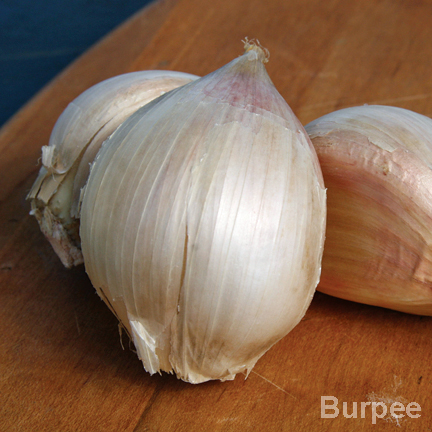
Come spring, the bulbs will stir and begin to produce strappy leaves.
If you’re growing hard neck garlic, harvest the scapes as they rise.
For all types, keep the bed free of weeds, and water every week or so, after the rains stop.
By mid-May or June, the leaves should start to turn brown.
Stop watering. Brush away the soil to check the size of the bulbs and the condition of their papery wrappers. If the cloves haven’t filled out the bulbs yet, and there are still many layers of parchment intact, wait another week, then check again.
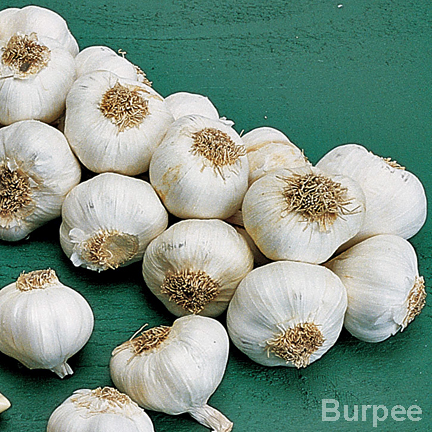
But if the bulbs are plump and only a couple of layers of parchment remain, it’s time to harvest. A word of warning: if all the layers of parchment disintegrate, the cloves will open up and become quite difficult to get out of the ground.
Lift out the bulbs with a hand fork or pitchfork. If you yank them by their tops, they may snap.
Wash off the dirt. Dry the bulbs outdoors, out of the sun, for a week or two. Once they’re dry, trim off the roots, pull off any straggly parchment, then braid or hang your garlic for storage.
The ideal storage temperature is 50 F. However, your garlic should still keep for several months or more, if you store it in single layers or hang it in a dry, well-ventilated dark location.
≈
Elephant Garlic
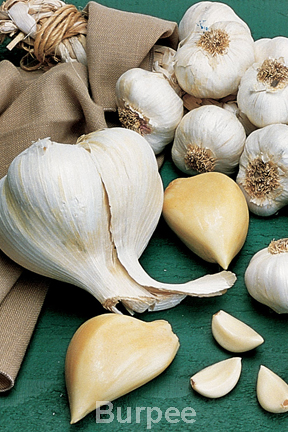
Botanically speaking, garlic belongs to the allium or onion family, which is composed of about 750 different species. All true garlics are varieties of the species Allium sativum, while the closely related elephant garlic is a different species, Allium ampeloprasum.
Scientific issues aside, individual bulbs of elephant garlic can weigh up to a pound and produce cloves two to three times as large as true garlic. And the taste tends to be more onion-like and mild.
In the garden, elephant garlic and true garlic require the same conditions. Just be sure to space the elephant cloves at least 8 inches apart, to accommodate their larger, mature size.
Also, elephant garlic may self-sow. If you grow it once, it’s likely to return.
≈
Garlic Sources
You can try planting garlic from the grocery store, but depending on whether and how the bulbs were treated, they might not sprout.
You can expect better luck by planting organic bulbs from specialty stores or farmers markets.
Or purchase your bulbs online, where you’ll find greater variety.
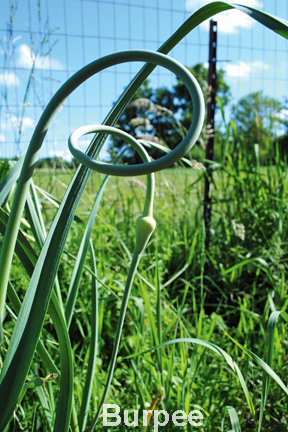
www.burpee.com
W. Atlee Burpee & Co.
300 Park Ave.
Warminster, PA 18974
800/888-1447
www.groworganic.com
Peaceful Valley Farm & Garden Supply
P.O. Box 2209
Grass Valley, CA 95945
888/784-1722
www.thegarlicstore.com
The Garlic Store
5313 Mail Creek Lane
Fort Collins, CO 80525
800/854-7219
www.hoodrivergarlic.com
Hood River Garlic
P.O. Box 1701
Hood River, OR 97031
541/386-1220
www.gourmetgarlicgardens.com
(an online marketplace of garlic growers)
≈
Seeds of Wisdom
Cook fresh garlic quickly over high heat for a sharp, pungent flavor. Cook it slowly over low heat for a soft, warm taste. Or serve it minced and raw for a real bite.
≈
Copyright, Joan S. Bolton. All rights reserved. Reproduction of text or photos in any form is prohibited without written permission.
≈
